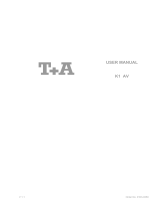
Flush-mounted radio with
display RAD...
Device description
The Jung flush-mounted radio RAD… consists
of a display cover and a flush-mounted
power supply unit.
The display cover is used for display and
operation. All the settings are made using
the 8 sensor buttons. The display shows the
station information from RDS, the time and
the current settings.
The radio power supply unit contains the
connections for the mains voltage, inputs
and the loudspeaker.
The radio can be operated with one or two
LSM... loudspeaker modules.
The extension input allows the radio to be
switched on or off, e.g. together with the
light.
The radio signal is obtained from the
connection to the mains voltage. In
situations where reception is difficult, the
optional cord aerial can be used.
Other audio sources can be played back
using an AUX input, e.g. using the music
centre MC..100… .
Safety information
Electrical equipment must only be installed
and assembled by qualified electricians.
Failure to comply with these instructions
may result in damage to the device, fire or
other hazards.
This product is only intended for use in dry
rooms.
These instructions are a component part of
the product and must remain with the end
customer.
Operation
The lower half of the cover is used for
operation. All operation is carried out using
8 sensor buttons.
When idle, the buttons and display may be
hidden, depending on the settings.
They are reactivated when the sensor
buttons are touched again.
Switch-on / Switch-off
The radio is switched on and off
here.
If the button is pressed for 3 seconds when
the system is switched on, then the sleep
timer (fall asleep function) can be activated.
Settings
Basic configuration of brightnesses,
alarm time, and much more.
Alarm functions
The alarm, which has a gradually
increasing volume, is switched on
and off here.
If the button is pressed for longer than
3 seconds, this opens the menu for setting
the alarm time.
Favourites
Preferred stations can be saved to
the Favourites or the AUX input
selected.
Operating buttons
Station search, volume setting and the
navigation/
setting in the menu.
Brightness of display during standby
adjusts the brightness for the
standby state.
The lowest level is Night mode.
Night mode
In Night mode, the display is switched off
completely as standby.
Pressing any button brings the display back
from Night mode.
Main menu
After switch-on, the station information and
status line are shown in the display.
The status line provides information on the
selected favourites, time and alarm
operation.
When idle, this information is reduced to the
time and date.
Station selection
The next station is selected using the
buttons.
RDS (Radio Data System)
During operation, the display shows the
station name and, in some cases, additional
information, e.g. on the current song.
If this information is not available, then
frequency information on the selected radio
station is displayed.
Adjusting the volume
The volume is adjusted using .
Favourites
Briefly pressing the button selects the
saved favourites or the AUX input.
Cancel Select -/+ Confirm
In radio operation, a long press of the
button (> 3 s) adds the current station to the
Favourites list.
Up to 8 favourites are possible.
Settings
The submenus can be found using the
button. The menu is operated with the
sensor buttons below.
Cancel Select -/+ Confirm
Here you can select one of the following 8
submenus with the +/- buttons.
With the button you get into the
selected submenu to change required
settings.
AUX input
When the AUX input is activated, radio
reception is terminated and playback comes
from the external source. If the input is
deactivated again, radio operation will
recommence.
Alarm time
The set alarm time starts the radio with an
increasing volume.
The display and buttons are previously
illuminated at full brightness.
The buttons terminate any further
increase in volume.
The button switches the alarm off.
The button switches the function on and
off.
Sleeptimer (Fall asleep function)
The Sleeptimer (fall asleep function)
switches the radio off automatically after
the selected period of time.
The countdown is displayed in the status
line.
Button brightness
The brightness and switch-off behaviour of
the buttons can be varied.
On switching-off, the information in the
display is reduced to the display of station
name and the time.
If the system is operated again, the buttons
become brighter again.
Brightness of operational display
The display brightness can be reduced.
Loudspeaker
During operation, the radio switches
between stereo and mono operation
automatically. If reception conditions are
variable, it may be wise to select continuous
mono operation. This allows two different
areas to be filled with sound.
Time
Normally, the reception of an RDS station is
sufficient to perform this setting
automatically. However, the current time
can also be set manually.
Default setting
The state as delivered is restored. In so
doing, the 8 strongest stations are saved
automatically.




